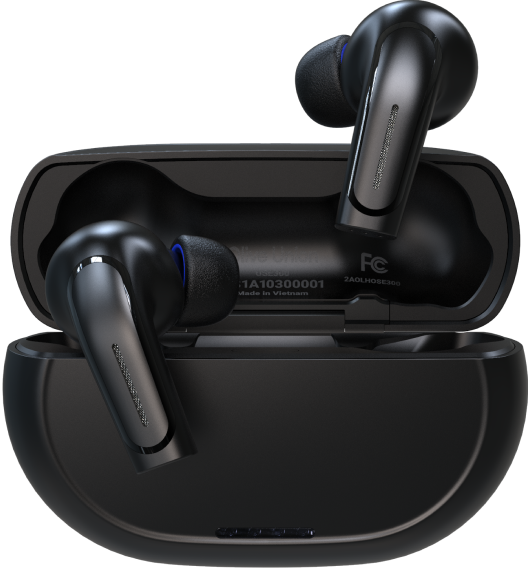
Despite commercially launching over 20 years ago, Bluetooth continues to remain synonymous with cool, modern technology. And for good reason! This highly functional technology is loaded into all manner of modern devices: phones, laptops, TV's, and speakers are just a few common examples.
And now joining this list, are hearing aids. Seemingly perfect for each other but only recently realized, the synergy and convenience between Bluetooth and hearing aids signals the start of a new generation for the hearing industry. These new Bluetooth hearing aids are here to stay.
What is Bluetooth? How Does it Work With Hearing Aids?
First, let's start with Bluetooth. Bluetooth is a wireless communication technology that can connect two devices, allowing them to share information using high frequency radio waves. It's safe and secure; most modern devices like your phone (or even your refrigerator!) use it. This is different from Wi-Fi, which connects a device to the internet.
Hearing aids equipped with Bluetooth can communicate with other electronic devices, such as your smartphone. The most well known example of this would be the iPhone - connecting your iPhone to hearing aids allows you to use the Live Listen feature, turning the iPhone into a big microphone that sends the amplified sound directly to your hearing aids. Other Apple products like the iPad also come equipped with this easy to connect wireless Bluetooth technology.
For devices other than an iPhone, you will most likely need a streamer device. This device is usually worn around the neck and acts as the middle man, receiving the information from the device and then sending it to your Bluetooth hearing aids.
The Difference Compared to Traditional Hearing Aids
Wireless Bluetooth hearing aids still perform the same role as traditional hearing aids - a miniature microphone picks up sound from the environment, which is then transmitted to the processor in the hearing aid. The processor converts this sound to a digital signal, which is then converted back into sound waves and transmitted to the speakers, and finally broadcasted to the users eardrums.
The main difference of a wireless Bluetooth hearing aid is the connectivity. Instead of taking out your traditional hearing aid to put in earbuds and listen to music, you can just connect your hearing device to your music player and listen directly.
The Benefits of Bluetooth Hearing Aids
Personalized Listening
When using a wireless hearing aid, you have greater control over all the settings of your hearing device. You can personalize the device to your own ears specific needs: louder volume in the left ear and higher amplification of a certain pitch in the right, for example.
Better Sound Quality
With Bluetooth wireless hearing aids, you stream audio directly into your ears, blocking every sound in the background. This leads to a better sound quality experience.
Binaural Hearing
With binaural hearing technology, a sound heard by one hearing aid will be sent to the other hearing aid as well, giving you better speech perception and a clearer listening experience. This function is particularly useful for phone calls, as it allows the caller's voice to be heard in both ears.
Remote Control
Bluetooth Hearing Aids with connectivity features can be controlled remotely. You can install a smartphone app that will allow you to adjust the settings, change the volume, and more discrete changes with ease.
Convenience
When using Bluetooth hearing aids, any notification or call over a cell phone rings in your hearing aids. With just the tap of a button you can instantly transition to a hands free and clear phone call. Wireless hearing aids also means no dealing with wires, an incredibly useful trait in our current mask wearing society!
Signal Stability
Interference in signals is common among digital devices. However, a Bluetooth device conveys sound using multiple channels, and hence it is less likely to cause any disruptions while hearing any music.
The Drawbacks of a Wireless Bluetooth Hearing Aid
Price
Bluetooth hearing aids are often a little costly when compared to the other kinds of hearing aids. For people who tend not to use Bluetooth technology such as smart TV's, smartphones, or speakers, sticking with a traditional hearing aid can save you some money.
Battery Drain
No technology is perfect; for all the convenience and features Bluetooth brings, it also brings a hefty energy cost. Bluetooth devices tend to drain battery considerably quicker than non-Bluetooth enabled devices. Compared to other hearing aids, you will need to charge your Bluetooth hearing aids more often.
Streamer Device
Not all, but some of the Bluetooth wireless hearing aids may require a streamer device to help transmit signals to the hearing aids. Some people may find it irritating to carry the device with them continually, especially if it of the around the neck variety.
The information in this guide has been written using the following reliable sources:
https://www.healthyhearing.com/help/hearing-aids/wireless
https://global.widex.com/en/blog/what-is-a-bluetooth-hearing-aid
https://myhearingcenters.com/blog/the-benefits-of-bluetooth-hearing-aids/
https://actiononhearingloss.org.uk/information-and-support/technology-and-products/
https://link.springer.com/referenceworkentry/10.1007%2F978-0-387-78665-0_6808
 (708) 847-3208
(708) 847-3208










